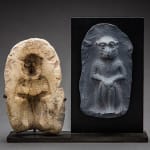Old Babylonian Clay Mould with Seated Monkey, 2000 BCE - 1700 BCE
baked clay
height 12.7 cm
height 5 in
height 5 in
LO.1165
The Old Babylonian period describes south Mesopotamia between 2000-1600 BC. The early years saw a number of important states dominating the region: Isin, Larsa, Eshnunna and, from 1894 BC, Babylon....
The Old Babylonian period describes south Mesopotamia between 2000-1600 BC. The early years saw a number of important states dominating the region: Isin, Larsa, Eshnunna and, from 1894 BC, Babylon. Babylon was ruled by a dynasty of Amorite kings. The sixth ruler was Hammurapi, who defeated the other southern states and expanded his control into north Mesopotamia. On the death of Hammurapi the empire gradually shrank over about 150 years. Nonetheless, Babylon remained an important power until it was sacked by the Hittite king, Mursili I, in about 1595 BC. During the Old Babylonian period literary activity flourished with scribes composing and recording religious, poetic and 'scientific' works in Sumerian and Akkadian cuneiform. Perhaps the most famous monument is the stele of Hammurapi, now in the Musée du Louvre, Paris.
This plaque belongs to a specific group of Old Babilonian objects depicting imagery borrowed and transformed from Egyptian sources. The delicately incised image on this small flat piece plaque can be identified by its characteristic cheek ridges and body form as the African guenon monkey depicted squatting and wearing a necklace of beads. The fur is rendered as a spotted coat. Monkeys were beloved by the ancient Egyptians, and their representations in Egyptian art show them both as mischievous pets, and as symbols of fecundity and magical sexual powers in the afterlife when depicted on scarabs and amulets.
This plaque belongs to a specific group of Old Babilonian objects depicting imagery borrowed and transformed from Egyptian sources. The delicately incised image on this small flat piece plaque can be identified by its characteristic cheek ridges and body form as the African guenon monkey depicted squatting and wearing a necklace of beads. The fur is rendered as a spotted coat. Monkeys were beloved by the ancient Egyptians, and their representations in Egyptian art show them both as mischievous pets, and as symbols of fecundity and magical sexual powers in the afterlife when depicted on scarabs and amulets.



